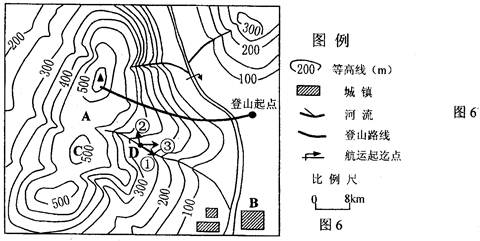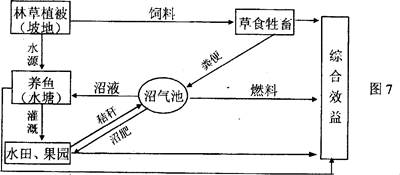图6是我国东部中亚热带某地等高线地形图,某校高中学生夏令营在图示区域进行了野外天文、地质、植被、聚落等综合考察活动。读图回答下列问题。(36分)

(1)同学们沿图中登山线路行进时,观察到沿途植被垂直变化不大。你认为主要原因是什么?
(2)若考察小组在D处突遇泥石流,①②③四条逃生线路中最佳的是;简要说明你选择的理由。(4分)
(3)同学们把夜晚宿营地点选在图中A处,从图中提供的信息简述理由。(4分)
(4)某同学建议在图中C处建一火情嘹望台,你认为此建议可采纳吗?____________。为什么?
若用现代化的手段动态监测山林火灾,最好采用_______________技术。(6分)
(5)从图中提供的信息简述城镇B兴起的主要区位条件。(6分)
(6)沿登山路线是否适合开垦梯田?简要说明理由。(4分)
该地位于中亚热带,过去以单一粮食生产为主,大量秸秆用作生活燃料。现在通过发展沼气,增加多层多级利用,农业生态系统走向良性发展。

(7)读图7分析在当地农村推广使用沼气产生的效益。(10分)
(1)(共2分)沿线相对高度不够大,水热状况垂直分异不显著
(2)(共4分)②远离山谷且海拔较高
(3)(共4分)地势较高,夏季相对凉爽(2分 )、位于鞍部,地形相对平坦开阔
(4)(共6分)不宜采纳;不能通视该山各个地点;遥感(RS技术)
(5)(共6分)位于开阔的谷地,地势平坦;靠近河流,可获得水源;有便利的水运条件
(6)(共4分)可以;(坡度大于 的山地,从生态角度考虑,不宜发展种植业)
通过计算,登山路线的坡度仅儿度(不到 ),说明坡度缓,可以辟为梯田。
(7)(共l0分)
(经济效益)提供沼肥、沼液、沼渣,有利于农业多种经营(农林牧渔的发展),增加收入:
(社会效益)解决农村生活用能,节约能源
(生态效益):沼气利用(是清洁能源)可减少农村大气污染物排放 :减少砍伐林木、薪柴,改善生态环境(涵养水源,保持水土):沼渣液可还田,增加土壤有机质:;地处中亚热带,发展沼气原料丰富,且全年可利用沼气(或沼气利用时间长)
